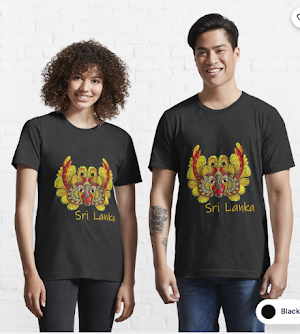Pahatharata Kolam dance
The kolam natima belongs to a different category of ritualised mask dance than the yakun natima. Today it is rarely practised and has been gradually losing its importance over the last hundred years. The early twentieth century writer Otaker Pertold commented that, even in his day, much of the original import of the dance had been lost, and that on the few occasions that it was still performed it was undertaken by laymen rather than edura or those specifically versed in ritual dances. Because some forty masked characters are involved in this elaborate drama, with commensurate offerings expected for certain devils and demons, Pertold cites the great expense involved in staging a full kolam natima as responsible for its gradual abbreviation.
As a ritual, the kolam natima broadly centres around pregnancy issues. The cravings and desires (dola duka) that often accompany a pregnancy were traditionally viewed with great suspicion, and were believed to be some sort of supernatural possession. The masked dance is thought to have been principally directed against these cravings and to protect the fetus in general.
As a ritual, the kolam natima broadly centres around pregnancy issues. The cravings and desires (dola duka) that often accompany a pregnancy were traditionally viewed with great suspicion, and were believed to be some sort of supernatural possession. The masked dance is thought to have been principally directed against these cravings and to protect the fetus in general.
The origin story and characters depicted in the kolam natima reflect some of this original intent:
The queen of a powerful king was pregnant. As her pregnancy neared term she developed an irresistible craving to see a masked dance performed. So intense was her desire that her health rapidly began to fail. 'She beseeched her husband, the king, to grant her this wish. The king asked his ministers what should be done, but no one knew what a masked dance was. In his desperation the king pleaded to the god Sekkria, asking that he should reveal what must be done. Hearing his plea, Sekkria instructed one of the four guardian gods, the God of Curiosity, to carve masks of sandalwood and place them in the king's garden with a book detailing what must be done. In the morning the gardener found masks distributed throughout the garden, some with the faces of devils, others of animals, and others of noble courtiers and ladies. The gardener rushed to the king and told him the news. He and the ministers gathered in the courtyard, discovered the explanatory text and a masked dance was performed immediately for the benefit of the queen.

It is assumed that the mask dance did the job, and that she suffered no more dola duka, and that the infant was a healthy one.
Near the final stages of the performance, as translated by Calloway in 1829, a pregnant woman enters the scene and after much anguish gives birth to a son, exclaiming: "The beauty of the child I have now got is like a flower. His prattle will be pleasant, and he will like much to chew betel [nut]." Care is urged for her son, and the demons and devils that threaten it are placated with offerings.
There is very little structure to the dance itself. Following a brief introduction and a retelling of its origins, the ritual consists primarily of a series of dances and walkthroughs by a set of characters; gods, humans, animals, and devils, each successive character being only loosely connected with what preceded. From the introduction at the court, we move out through the village catching glimpses of village life before moving into the woods, where the threats and ferocity of the animals give way to the terror of devils and demons.
Thus the impact of the kolam natima lies not in its great narrative strength but in the pure spectacle of the masks: the Lasquarine soldier who lost his nose in the great battle of Gampelle; the great Virgin of the Snakes with her radiant face surrounded by coiled cobras; the golden faced and seductive woman with five bodies; the greedy moneylender, Hettiya the haggard old man and old woman dressed in rags looking for support from the young villagers; the innocent bullock attacked by a ferocious tiger and a pack of hungry jackals; cavorting monkeys with shaggy beards and gaping mouths; the awesome devil Nanda Gere with two devil faces on each side, with gnashing teeth and a body caught in his jaws , and Yamma Raksaya, the black-faced devil of death with his long tusks, demon faces flanking his own and coiled naga serpents crowning his head














meka sinhalen thiyenawanam hodai.
ReplyDeleteow puluwannam sinhalen dannako
DeleteGodak watinawa
ReplyDeleteThere is a Conservation Center for Traditional Kolam masks & Dance at No 35 , Maha Ambalangoda , Ambalangoda ... You can get/ learn more accurate details of Art of Traditional Kolam dance by contacting them... https://www.google.lk/search?_ga=2.78645332.1706570177.1650992281-1179922634.1641303822&q=Sri+Lankan+Traditional+Masks+%26+Dance+-+Tukkawadu+Generation&ludocid=2421853373201968557&lsig=AB86z5WEVRepofqkQWcGpJvUmruW
ReplyDeletehttps://g.page/r/Ca3tyLfPJpwhEBA
DeleteNa na meka ohoma thiyanna
ReplyDelete